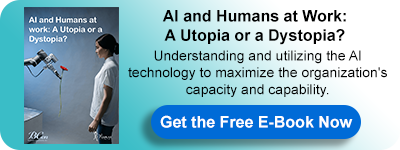AI: Is It a Replacement or an Augmentation?
Artificial intelligence is rapidly improving many "human" tasks, such as disease diagnosis, language translation, and customer service. As a result, there are valid concerns that AI will someday substitute human occupations across the board. However, that isn't the only or even the most likely scenario.
Never before have we, or our digital tools, been so attentive to them. It was predicted that By 2021, artificial intelligence would manage 15 percent of all customer support interactions, up 400% from 2017. In 2022, machine learning, chatbots, and mobile messaging will account for 72 percent of interactions, up from 11 percent in 2017. These are just a few of the statistics presented at a Gartner conference on the emergence of AI and new technologies and their impact on the customer experience.
The advantages are enormous - for both consumers and businesses. Regardless of how complicated a customer's query is, they will receive faster service and a more personalized experience. Thanks to automation, brands will be more efficient, scalable, and cost-effective in their operations.
While AI will change the way work is done and who does it, it will significantly impact complementing and augmenting human capabilities and, in some unfortunate cases replacing them.
When integrated with other cutting-edge technologies like robotics and 3D printing, artificial intelligence will result in more efficient goods and service production. Advanced robotics can increasingly do manual chores, and machines can be educated to execute a wide range of non-routine cognitive tasks. Increased productivity and lower costs will benefit society as a whole, but many individual workers may suffer as a result.
According to research, about half of today's workers work in industries likely to be disrupted soon. Machines will replace workers in some circumstances, such as truck drivers. Work will be revolutionized in other domains, such as education and medical, with computers completing some jobs in close conjunction with trained humans performing others.
One of the most critical aspects of AI-driven job loss is that some jobs will withstand automation for a far more extended period than others. Humans will continue to outperform machines in jobs that are not necessarily the most cognitively demanding for the foreseeable future. Instead, they will be those in which our humanity is a critical component.
Empathy, camaraderie, social engagement, and the "human touch" are among the most important. Human babysitters, nurses, therapists, school teachers, and social workers, for example, will be in need for many years.
Humans will not be replaced in positions that require true inventiveness and unusual thinking anytime soon. The following is a cliché yet informative proverb concerning man's relationship with AI: as AI improves at knowing the proper answers, humans' most essential duty will be to know which questions to ask. Academic researchers, entrepreneurs, technologists, artists, and writers are just a few examples of jobs that require this kind of creativity.
People will spend less of their energy on dull, repeatable, soulless chores and more on creating human relationships, managing interpersonal dynamics, and thinking creatively in the jobs that do exist as the years pass.
It will take decades for AI to spearhead the transition to a post-work future. It will be inconvenient and painful. It will necessitate a significant transformation of our culture and ourselves.
When we read the above, we automatically assume a dystopian image. Robots roaming around, and humans hiding at home waiting to be replaced in every nook and cranny. Yet, the image is not that dark. It's critical not to overlook the human aspect of the human experience in any industry or sector.
According to Gartner's forecasts, a human agent will be involved in 44 percent of all customer support encounters, even though phone-based communication will shrink from 41 percent to 12 percent of total customer service interactions. It will be critical to look beyond the hype surrounding these new technologies. You must understand how artificial intelligence (AI) and natural language processing (NLP), for example, might assist in revolutionizing business operations and be used to meet consumer needs, support agents, and boost efficiency in the future. However, the future of customer experience will be defined by a careful balance of technology and human interaction. Let's wait and see how the future unfolds as time goes by.
1HBR, July Aug 2018, H.James Wilson and Paul R. Daugherty, Collaborative Intelligence: Humans and AI are Joining Forces, Accessed 3 Mar 2022, https://hbr.org/2018/07/collaborative-intelligence-humans-and-ai-are-joining-forces
Forbes, 15 Feb 2021, Rob Toews, Artificial Intelligence and the end of work, Accessed 3 Mar 2022, https://www.forbes.com/sites/robtoews/2021/02/15/artificial-intelligence-and-the-end-of-work/?sh=898064856e3b
EngHouse Interactive, 17 Jul 2018, Neil Cox, Striking the Balance between Humans and EI in CX, Accessed 3 Mar 2022, https://www.eptica.com/blog/striking-balance-between-humans-and-ai-cx
Stanford News, 17 May 2018, Clifton B. Parker, AI will both benefit and disrupt the workplace, Accessed 3 Mar 2022, https://news.stanford.edu/2018/05/17/artificial-intelligence-workplace/
For more about this topic, download our latest book " AI and Humans at Work: A Utopia or a Dystopia? " for FREE:
